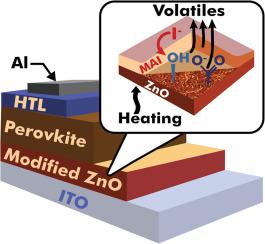Nano Energy ( IF 16.8 ) Pub Date : 2021-01-13 , DOI: 10.1016/j.nanoen.2021.105774 Sergey Tsarev , Selina Olthof , Aleksandra Boldyreva , Sergey M. Aldoshin , Keith J. Stevenson , Pavel A. Troshin

|
Low operational stability of perovskite solar cells represents a major obstacle for practical implementation of this technology. In that context, ZnO was considered as a promising electron transport material with suppressed oxidizing properties as compared to SnO2 and TiO2. However, the first studies revealed the chemical instability of the interface between lead halide perovskites and zinc oxide, whereas the underlying reasons are still under active debates. Still, the interfacial instability issues made ZnO a largely overlooked electron transport layer despite its excellent optoelectronic properties. This study presents a novel approach to the zinc oxide surface modification with methylammonium iodide that suppresses further reactions with the adjacent perovskite absorber layer. Consequently, the solar cells based on CH3NH3PbI3 exhibited largely improved thermal stability. Furthermore, the application of Cs0.12[HC(NH2)2]0.88PbI3 as absorber material in devices with the modified ZnO electron transport layer resulted in 82% retention of the initial efficiency after aging for 2100 h at 50 mW cm−2 and 65 °C. On the contrary, the reference cells fabricated with the pristine non-modified ZnO degraded completely under the same conditions. We attribute the revealed stabilization effect of the methylammonium iodide treatment to passivation of the reactive ZnO surface and inhibiting the parasitic interfacial chemistry leading to the lead iodide formation. To our best knowledge, here we have demonstrated the highest operational stability for the perovskite cells when using ZnO-based ETL.
中文翻译:

用甲基碘化碘对氧化锌进行反应性改性可提高钙钛矿太阳能电池的运行稳定性
钙钛矿太阳能电池的低操作稳定性代表了该技术的实际实施的主要障碍。在这种情况下,与SnO 2和TiO 2相比,ZnO被认为是一种有望抑制氧化性能的电子传输材料。。然而,最初的研究揭示了卤化钙钛矿和氧化锌之间界面的化学不稳定性,而根本原因仍在积极争论中。尽管如此,界面不稳定性问题仍使ZnO具有优异的光电性能,但却成为很大程度上被忽视的电子传输层。这项研究提出了一种使用甲基碘化碘对氧化锌表面进行改性的新方法,该方法可以抑制与相邻钙钛矿吸收层的进一步反应。因此,基于CH 3 NH 3 PbI 3的太阳能电池表现出大大改善的热稳定性。此外,Cs 0.12 [HC(NH 2)2 ] 0.88的应用在具有修饰的ZnO电子传输层的器件中,作为吸收体材料的PbI 3在50 mW cm -2和65°C的条件下老化2100 h后,导致初始效率保留82%。相反,使用原始未修饰的ZnO制成的参考电池在相同条件下会完全降解。我们将甲基碘化铵处理所揭示的稳定作用归因于反应性ZnO表面的钝化并抑制了导致碘化铅形成的寄生界面化学。据我们所知,这里我们展示了使用基于ZnO的ETL时钙钛矿电池的最高运行稳定性。











































 京公网安备 11010802027423号
京公网安备 11010802027423号